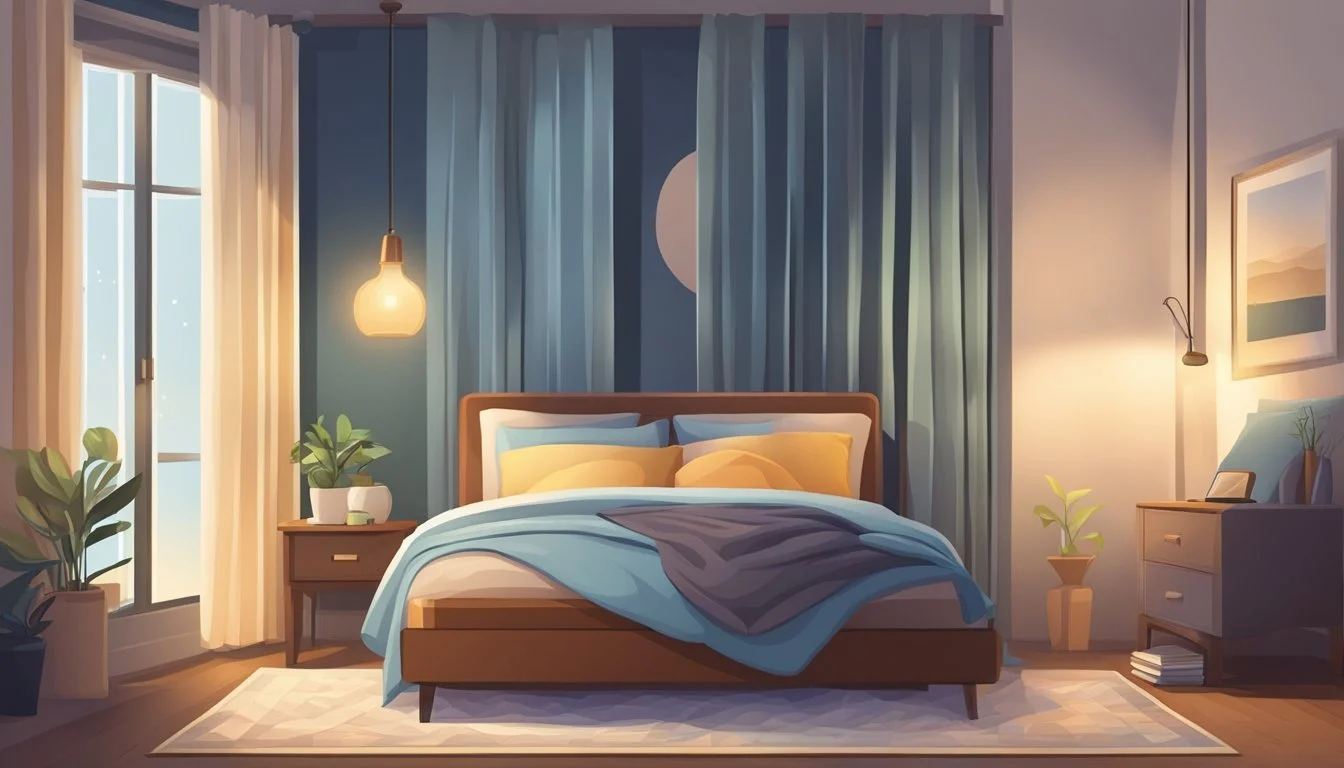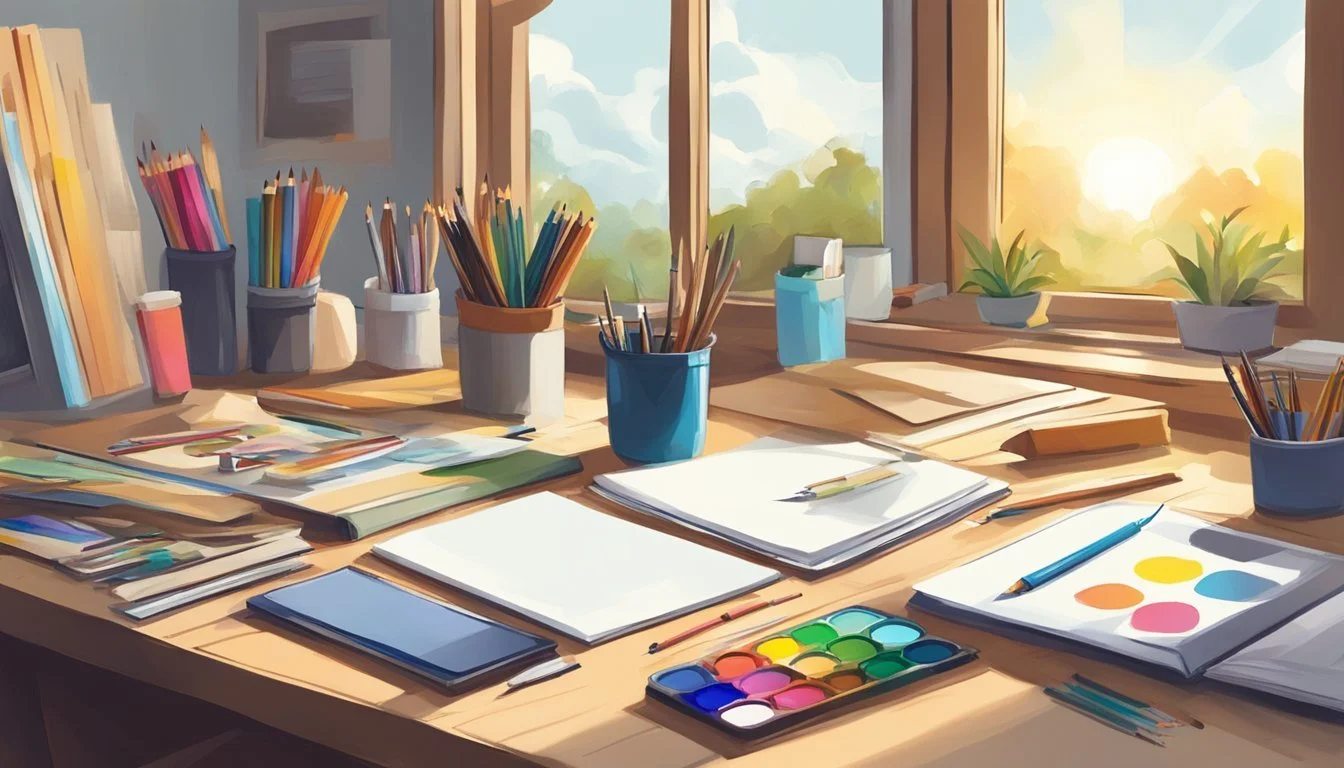12 Ways to Boost Your Creativity Daily
Simple Habits for Innovative Thinking
Creativity is a valuable skill that can enhance many aspects of life, from problem-solving to artistic expression. In today's fast-paced world, finding ways to nurture and develop creativity has become increasingly important for personal and professional growth.
Incorporating simple practices into daily routines can significantly boost creative thinking and output. These strategies can help individuals tap into their innate creative potential, overcome mental blocks, and generate fresh ideas. By consistently engaging in creativity-enhancing activities, people can cultivate a more innovative mindset and approach challenges with greater imagination and flexibility.
1) Practice Mindfulness
Mindfulness is a powerful tool for enhancing creativity. It involves focusing on the present moment and observing thoughts without judgment. Regular mindfulness practice can help quiet the mind and create space for new ideas to emerge.
One simple way to incorporate mindfulness is through breathing exercises. Taking a few deep breaths and focusing on the inhale and exhale can quickly center the mind. This can be done anywhere, at any time.
Body scan meditations are another effective technique. Starting from the toes and moving up to the head, one can systematically relax each part of the body. This helps release tension and promotes a state of calm alertness.
Mindful observation of surroundings can also spark creativity. Taking time to notice details in nature or everyday objects can open up new perspectives. This heightened awareness can lead to fresh insights and inspiration.
Incorporating brief mindfulness exercises throughout the day can have cumulative benefits. Even just a minute of focused attention can help reset the mind and boost creative potential.
2) Use a Creativity Journal
A creativity journal serves as a personal space to explore ideas and spark imagination. This tool can be a simple notebook or a digital document dedicated to capturing thoughts, sketches, and inspirations.
Daily journaling prompts can help overcome creative blocks. Writers might describe a vivid childhood memory or draft a letter to their future self. Visual artists could sketch an object from multiple angles or experiment with new color combinations.
Gratitude lists in a creativity journal can shift perspective and open new avenues of thought. Noting small joys or unexpected beauty in everyday life often leads to fresh insights and innovative ideas.
Poetry exercises in the journal can stimulate creative thinking. Playing with metaphors, rhymes, and similes enhances linguistic creativity and can generate novel concepts for various projects.
A creativity journal also functions as a repository for future reference. Ideas jotted down may not seem significant initially but can evolve into major projects or solutions to complex problems later on.
3) Read Fiction Daily
Reading fiction is a powerful way to boost creativity. It exposes the mind to new ideas, characters, and worlds, stimulating the imagination. Fiction engages different areas of the brain, enhancing cognitive flexibility and creative thinking.
Regular fiction reading improves empathy and understanding of others. This heightened emotional intelligence can lead to more creative problem-solving in various aspects of life. The act of visualizing scenes and characters while reading also exercises the mind's creative muscles.
Fiction often presents unique perspectives and unconventional solutions to problems. This exposure can inspire readers to think outside the box in their own creative pursuits. Reading fiction before bed can also prime the mind for creative thoughts during sleep and upon waking.
To incorporate this habit, start with short stories or novellas if time is limited. Gradually increase reading time as the habit becomes established. Choose diverse genres to broaden exposure to different writing styles and ideas.
4) Take Regular Breaks
Taking regular breaks throughout the day can significantly boost creativity. Stepping away from work allows the mind to reset and approach tasks with fresh perspectives.
Short breaks every 60-90 minutes can help maintain focus and energy levels. During these pauses, individuals can engage in activities that stimulate different parts of the brain.
A quick walk outdoors exposes the mind to new stimuli and environments, potentially sparking innovative ideas. Engaging in brief meditation or deep breathing exercises can clear mental clutter and improve concentration.
Switching to a creative hobby during breaks, such as sketching or playing an instrument, activates different cognitive processes. This mental shift can lead to unexpected connections and insights when returning to work.
Scheduling breaks in advance ensures they become a consistent part of the daily routine. This practice prevents burnout and maintains a steady flow of creative energy throughout the day.
Proper break management enhances overall productivity and creative output. By allowing time for mental rest and exploration, individuals can return to tasks with renewed focus and imaginative potential.
5) Explore New Hobbies
Engaging in new hobbies can significantly enhance creativity. Trying different activities exposes the mind to fresh experiences and perspectives, stimulating innovative thinking.
Candle making is an accessible hobby that allows for artistic expression. It requires simple materials like wax and wicks, making it easy to start at home.
Button making offers another creative outlet. With a manual button-making machine, individuals can design and produce custom buttons, fostering a sense of accomplishment.
Scrapbooking combines memory preservation with artistic flair. This hobby encourages creative arrangement of photos, mementos, and decorative elements.
Upcycling transforms old items into new creations. This eco-friendly hobby challenges individuals to reimagine and repurpose objects, promoting resourceful thinking.
Local clubs and classes provide opportunities to explore various hobbies. Joining these groups not only teaches new skills but also connects like-minded individuals, fostering a supportive creative environment.
6) Change Your Environment
Altering your surroundings can significantly impact creativity. A simple change of scenery often sparks new ideas and fresh perspectives. Moving to a different workspace, such as a coffee shop or park, can break the monotony and stimulate innovative thinking.
Even small changes within your current space can make a difference. Rearranging furniture, adding plants, or changing the lighting can create a renewed sense of inspiration. These adjustments can help shift mental patterns and encourage creative problem-solving.
Working in nature or outdoor settings has been shown to boost creativity. The natural environment provides sensory stimulation and a sense of calm that can enhance cognitive function and imaginative thinking.
For those unable to change physical locations, virtual environments can offer a similar effect. Using different desktop backgrounds or working in virtual reality spaces can provide the mental shift needed to unlock creativity.
Changing your environment doesn't always require a drastic move. Sometimes, simply facing a different direction in your current workspace or switching to a standing desk can provide enough novelty to spark creativity.
7) Collaborate with Others
Collaboration can spark new ideas and perspectives, enhancing creativity. Working with others exposes individuals to diverse viewpoints and experiences, which can lead to innovative solutions.
Brainstorming sessions with colleagues or friends can generate a wealth of ideas. These sessions allow for the free exchange of thoughts and encourage building upon each other's concepts.
Creative partnerships often result in outcomes that surpass individual efforts. By combining different skill sets and knowledge bases, collaborators can create more comprehensive and original work.
Online platforms and tools make it easier than ever to collaborate remotely. Virtual workspaces enable creative minds to connect and share ideas across distances, broadening the potential for unique collaborations.
Seeking feedback from others during the creative process can help refine and improve ideas. Constructive criticism and alternative perspectives can highlight blind spots and inspire new directions.
Collaborative projects also provide opportunities to learn new techniques and approaches. Observing how others tackle creative challenges can expand one's own creative toolkit and problem-solving abilities.
8) Challenge Yourself with New Skills
Stepping out of one's comfort zone and learning new skills can significantly boost creativity. By engaging in unfamiliar activities, individuals stimulate different parts of their brain, fostering novel connections and ideas.
Trying a new hobby or craft can be an excellent way to challenge oneself. This could involve learning to play a musical instrument, taking up painting, or experimenting with photography.
Learning a new language is another effective method to enhance creative thinking. It exposes the mind to different ways of expressing ideas and concepts, potentially leading to innovative thought patterns.
Physical activities like dance or martial arts can also contribute to creativity. These pursuits require coordination, rhythm, and spatial awareness, which can translate into improved problem-solving skills in other areas.
Technical skills such as coding or graphic design can open up new avenues for creative expression. These abilities allow individuals to bring their ideas to life in digital formats, expanding their creative horizons.
Challenging oneself with new skills not only boosts creativity but also builds confidence and resilience. The process of learning and improving in unfamiliar areas can lead to a more flexible and adaptable mindset.
9) Set Aside Creative Time
Dedicating specific time for creative pursuits is essential for nurturing and expanding one's artistic abilities. By establishing a regular schedule for creative activities, individuals can train their minds to enter a creative state more easily.
Carving out even short periods, such as 15-30 minutes daily, can make a significant difference in creative output. This consistent practice helps build momentum and keeps creative muscles active.
Choosing the right time of day is crucial. Some people find their creativity peaks in the early morning, while others are more inspired in the evening. Experimenting with different times can help identify the most productive creative hours.
Creating a designated space for creative work can enhance focus and minimize distractions. This area can be as simple as a corner of a room or a specific desk used solely for creative endeavors.
Setting realistic goals for each creative session helps maintain motivation and provides a sense of accomplishment. These goals can range from brainstorming new ideas to completing small projects.
10) Engage in Physical Exercise
Physical activity can significantly boost creativity. Regular exercise has been shown to improve cognitive function and enhance divergent thinking, a key component of creative problem-solving.
Aerobic exercises like running, cycling, or swimming can increase blood flow to the brain, promoting the growth of new neurons and improving overall brain health. This improved brain function can lead to enhanced creative capabilities.
Studies have found that people who exercise regularly tend to be more creative than those who don't. Even short bursts of moderate-intensity exercise can have immediate positive effects on creative thinking.
Exercise also helps reduce stress and improve mood, which can free up mental space for creative thoughts. It provides a break from focused work, allowing the mind to wander and make unexpected connections.
Incorporating physical activity into daily routines can be as simple as taking a brisk walk during lunch breaks or doing a quick workout before starting creative tasks. The key is consistency and finding enjoyable forms of exercise.
11) Get Enough Sleep
Sleep plays a crucial role in boosting creativity. Research suggests that getting adequate rest enhances imaginative thinking and problem-solving abilities.
Both non-REM and REM sleep stages contribute to creative processes. During sleep, the brain consolidates memories and makes new connections, which can lead to novel ideas and insights.
Studies show that well-rested individuals are more adept at generating innovative concepts. Aim for 7-9 hours of sleep per night to optimize creative potential.
Establishing a consistent sleep schedule helps regulate the body's internal clock. This can improve sleep quality and make it easier to fall asleep and wake up naturally.
Creating a relaxing bedtime routine can prepare the mind for rest. Activities like reading, gentle stretching, or meditation can help transition from wakefulness to sleep.
Limiting exposure to blue light from electronic devices before bedtime can improve sleep quality. Consider using blue light filters or avoiding screens an hour before sleep.
By prioritizing sleep, individuals can enhance their creative abilities and approach challenges with fresh perspectives.
12) Listen to Music
Music has a profound impact on the human brain and can significantly enhance creativity. Listening to melodies and rhythms stimulates various regions of the mind, potentially unlocking new ideas and perspectives.
Different genres of music can evoke distinct emotional responses and cognitive states. Classical music, for instance, may improve spatial-temporal reasoning, while jazz can encourage improvisation and spontaneous thinking.
Creating a personalized playlist for creative tasks can be beneficial. Instrumental tracks often work well for focus, while lyrics might inspire writers or poets. The key is to experiment and find what resonates with individual creative processes.
Music can also serve as a mood enhancer, reducing stress and anxiety that might hinder creative flow. Upbeat tunes can energize and motivate, while calming melodies may help during brainstorming or reflection periods.
For some, background music provides a consistent auditory environment, masking distractions and creating an ideal space for creative work. Others might find inspiration in actively listening to new or unfamiliar music, broadening their artistic horizons.
Understanding Creativity
Creativity is a fundamental human ability that drives innovation and problem-solving. It involves generating original ideas and making unique connections between concepts.
Definition and Importance
Creativity is the capacity to produce novel and valuable ideas or solutions. It encompasses imagination, originality, and innovation. Creative thinking is crucial in various fields, from arts and sciences to business and technology. It enables individuals to approach challenges from fresh perspectives and develop innovative solutions.
Creativity fosters personal growth, enhances problem-solving skills, and promotes adaptability in an ever-changing world. It allows people to express themselves, connect with others, and contribute meaningfully to society. In professional settings, creativity drives innovation, improves efficiency, and gives organizations a competitive edge.
The Science Behind Creativity
Neuroscience has shed light on the brain processes involved in creative thinking. Research shows that creativity engages multiple brain regions, including those responsible for memory, emotion, and cognitive control. The default mode network, active during daydreaming and mind-wandering, plays a significant role in creative ideation.
Studies have identified factors that influence creativity, such as mood, environment, and cognitive flexibility. Positive emotions and relaxed states can enhance creative output. Exposure to diverse experiences and ideas also stimulates creative thinking by forming new neural connections.
Neuroplasticity allows individuals to strengthen their creative abilities through practice and targeted exercises. Techniques like mindfulness meditation and divergent thinking tasks can improve creative problem-solving skills over time.
Practical Techniques to Enhance Creativity
Several proven methods can significantly boost creative thinking skills. These techniques tap into different aspects of the mind to spark new ideas and perspectives.
Mind Mapping
Mind mapping is a visual brainstorming technique that helps organize thoughts and generate new connections. Start by writing a central concept in the middle of a page. Branch out with related ideas, using colors and images to enhance visual appeal.
This method encourages non-linear thinking and allows for quick capture of fleeting thoughts. It's particularly useful for project planning, problem-solving, and exploring complex topics.
Mind maps can be created on paper or using digital tools. Many software options offer templates and collaborative features for team brainstorming sessions.
Creative Journaling
Creative journaling combines writing and visual elements to express ideas and emotions. It provides a private space for experimentation and self-reflection.
Use a blank notebook to write freely, sketch, or collage. Try different prompts each day to spark new ideas:
Describe an object from an unusual perspective
Write a conversation between two unlikely characters
Draw your current mood
Regular journaling helps develop a creative routine and overcome mental blocks. It also serves as a record of personal growth and inspiration for future projects.
Meditation and Mindfulness
Meditation and mindfulness practices can enhance creativity by reducing stress and improving focus. Set aside 10-15 minutes daily for quiet reflection.
Try these simple exercises:
Focus on your breath for 5 minutes
Observe your surroundings without judgment
Practice body scans to release tension
These techniques clear mental clutter and create space for new ideas to emerge. They also improve cognitive flexibility, allowing for more innovative problem-solving approaches.
Regular practice can lead to increased self-awareness and emotional regulation, both valuable skills for creative work.








